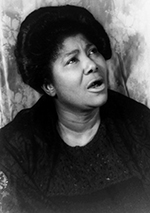By Terry Goodrich
The Black Gospel Music Restoration Project — a search-and-rescue mission launched by a Baylor University researcher to save little-known recordings from the Golden Age of black gospel — will become a permanent feature of the Smithsonian Institution’s National Museum of African American History and Culture.
The collection, managed and maintained by Baylor Libraries’ Digital Projects Group, will be among materials displayed at the museum, according to museum officials and the project’s founder, Robert Darden, an associate professor of journalism, public relations and new media at Baylor. The museum will open its doors in 2015.
 “When we first conceived what would become the Black Gospel Music Restoration Project, we really had two goals in mind … both of which seemed impossibly distant and far-fetched at the time,” Darden said. “One, we wanted to begin the never-ending process of identifying, acquiring, digitizing and cataloguing gospel music’s fast-vanishing vinyl legacy.
“When we first conceived what would become the Black Gospel Music Restoration Project, we really had two goals in mind … both of which seemed impossibly distant and far-fetched at the time,” Darden said. “One, we wanted to begin the never-ending process of identifying, acquiring, digitizing and cataloguing gospel music’s fast-vanishing vinyl legacy.
“The second goal dream was to make this priceless, extraordinary music widely available,” he said. “Working with the Smithsonian’s new National Museum of African American History & Culture will go a long way to making that second dream a reality.”
While vintage albums by such legends as Mahalia Jackson are available on CDs, music by lesser-known greats such as the Spirit of Memphis were hard to find, as Darden discovered while writing his book People Get Ready! A New History of Black Gospel Music.
From the 1940s through the 1970s, because of primitive technology and expense, it was hard for many musicians to make live recordings — usually 45rpm or 78rpm records, Darden said. A surprisingly large number of “B” sides of old 45s of gospel songs address the subject of civil rights, the Vietnam War and other social issues.
Darden and Dwandalyn Reece, the NMAAHC’s music and performing arts curator, view the recordings as an important addition to help museum goers understand gospel music’s contribution to both societal issues and spiritual life.
The collection now includes nearly 8,500 “sides” digitized — LPs and 45s, primarily. It will be part of the NMAAHC Musical Crossroads exhibition to help tell the story of African-American music from the arrival of the first Africans in America through the present.
